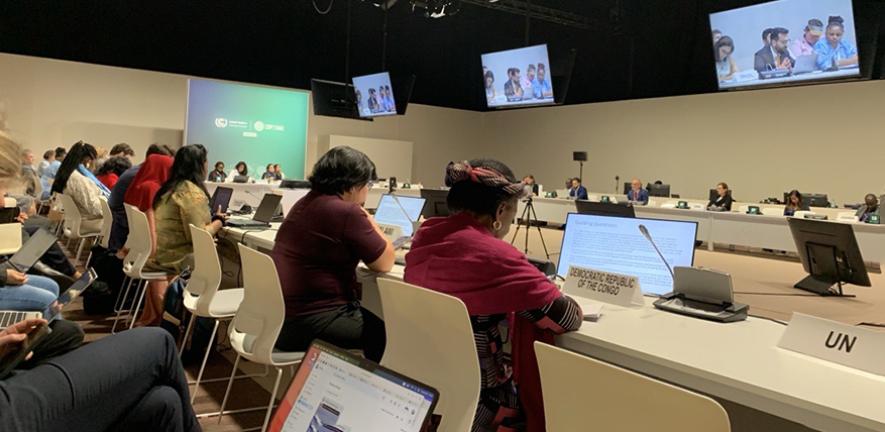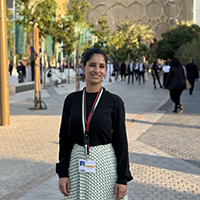
I am sitting on a plane, looking out onto a hazy sea that seems to blend seamlessly with wisps of cloud so that it is not clear where one ends and the other begins. The view is interrupted by occasional clusters of oil rigs, and then a few sandbars, and finally the marshy coastline of northeastern Arabia, or at least, what remains of it.
Is my flight contributing to its destruction? Many have pointed out the irony of our collective carbon churning flights to attend a climate change conference, and while the irony is not lost on us, the widely held view is that the benefits of convening collective action to curb man-made climate change outweigh the costs of travelling for the event.
COP28 was the UN’s 28th annual ‘Conference of the Parties’ on climate change, bringing some 200 nations to the negotiating table, where the parties can agree and commit to action that will address climate change. Besides the main UN programs, there were hundreds of pavilions that also hosted their own programs. This meant that COP this year had a whopping ~100,000 people registered, almost twice as many as COP26 in the UK two years ago. While this ‘fringe’ part of COP is criticised by some as a bit of a ‘trade show’, it demonstrates an increasingly unified voice from the private sector, NGOs, research institutions and communities. Climate change is a unique challenge in that every person and every entity is a stakeholder, and COP this year gave them a bigger forum to come together, raise their voices to the country parties, and push forward collective action. And this was the aim of Cambridge University’s delegation, which I was lucky enough to be part of. With broad representation from across the University, our program brought together universities, businesses, and youth in an effort to send a clear message to policymakers while galvanising tangible action. You’ll find an overview of the University’s COP28 activities here.
I lead on the University’s strategic industry partnerships that aim to decarbonise industries. As the climate change challenge is becoming increasingly urgent, the University now aims to ramp up its contribution to the green transition, and strategic partnerships are a key part of that. So I attended COP28 with a view to understand the global position of the private sector and identify new opportunities and routes for strategic collaboration. For example, one of Cambridge University’s strengths is discovery science, such as is applicable to long-duration energy storage. However, we need to speed up deployment if we are to address climate change in time. This can only happen through partnerships with industry that will push these technologies out to the world. The need for a just transition, however, means that we need to rethink traditional partnership models, and think more broadly and on longer timescales.
I had the opportunity to explore this as part of a panel hosted by the Higher Education Pavilion addressing the topic of ‘Transdisciplinary academic approaches to climate solutions’. I was joined on the panel by brilliant colleagues from Pennsylvania State University and the University of Southern California. The discussion focused on how to go beyond academic interdisciplinarity to transdisciplinarity by working with different stakeholders, such as policymakers, communities and the private sector. We concluded by sharing lessons on training graduates to work in this transdisciplinary way and agreed that working with multiple stakeholder groups can scale our impact. From our own experience at Cambridge University, we’ve seen this to be the case by bringing the private sector together with policy makers, for example, through our work on sustainable aviation, sustainable freight, or through the Corporate Leaders Group, and we are keen to do more.
Reassuringly, the presence of the private sector at COP28 showed that they are also keen. I was impressed with the breadth of the private sector’s presence as well as the quality of the programs hosted, particularly those that were action oriented. This includes the finance sector who seemed to show a strong willingness to invest in green growth. Perhaps the biggest highlight for me was seeing the narrative start to shift from the green transition being a problem to be solved almost by regressing in human development and quality of life, and instead presenting it for the opportunity that I believe it is: an opportunity to develop sustainably, moving humanity forwards and bringing everyone along, improving lives and habitats around the globe. This sentiment was echoed throughout the conference, whether it was the private sector discussing growth opportunities with huge economic potential, the public sector discussing the growing job market that far outnumbers expected job losses, or local communities and NGOs discussing environmental repair and protection. I was also particularly pleased to see a strong focus on a just and inclusive transition, and a presence of indigenous peoples.
Now that the conference has concluded, we have clarity over the global stocktake and the fact that the previous pledges set us on route to a worrying 2.4-2.6 degree temperature rise by 2050, so we do need to correct our course. Because of this, there is disappointment that the final agreement is somewhat watered down from the original ambition. However, for me there are three highlights to celebrate. Firstly, this is the first agreement to mention a transition away from fossil fuels. Secondly, the nations have pledged to triple renewable energy capacity and double energy efficiency by 2030. Thirdly, the agreement to set up a loss and damage fund is a triumph as it acknowledges that there is damage to be repaired and clarifies the responsibilities of richer nations in paying for the repair. While the agreement does not lay out detailed plans on how the targets are to be met, it does set a clear direction of travel, and that direction is away from fossil fuels. Hopefully, this will allow the nations to chart their courses in this direction and will reassure the private sector on where to put their investments.
There is universal acknowledgement that no one entity will be able to address climate change alone. Partnerships are crucial, and I return from COP28 with numerous connections and leads for collaborations. Unexpectedly, many of these connections were made serendipitously while waiting in queues or sharing coffee tables. In the end, I do not know if my personal attendance was worth the carbon cost of my flight, but I will strive to make it so. Working on the green transition does not only happen at COP, rather, it is continuous, unrelenting work, with COP being a point in the year for the nations to come together and publicly agree their commitments. I return with renewed inspiration, motivation and commitment to maximise our contribution to the green transition. We all need to do our part, but none of us can work alone in a transition of this scale. We aim to increase our multi-faceted, strategic partnerships that can contribute to decarbonising industries and sectors. I look forward to seeing our collaborations grow, and I invite you to think of how you can maximise your impact. If you think you can do so by partnering with Cambridge University, get in touch.

Manar Alsaif,
Energy Sector Lead, Strategic Partnerships Office
December 2023
